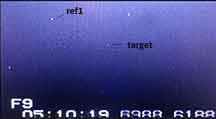


This is an event that showed up with the new GAIA data release and much better (in calculations at least, so far. We shall see) accurate orbits and predictions. This event is still difficult, but convenient in time and not that far away. The drop is full, but lasts only 0.5 seconds. For a 13.0 star, this will require keep the gain at maximum and the integration short. 4x I hope will do. The moon will be up, but only 8 degrees up, and 36 degrees away from the target. Not perfect, but not terrible. It's a gibbous moon. The site is in Moss Landing at the south end. I'm tentatively planning on watching the 49rs game and then driving to Cabrillo to get some work done before continuing on to the occultation site. If clouds looks too iffy, I may skip this one. Text me, Kirk, if you're interested in joining this.
 |
 |
 |
I'd originally hoped to meet with Kirk at Cabrillo after the 49er NFC Championship game, but I texted him at the end of the game and the sky was too cloudy to justify the effort.... But then...
I was in the Aptos Hills with friends till 7:30pm, too late to try to get any observatory work done at Cabrillo and then try to get back to Moss Landing for this event. But, it looked too cloudy initially anyway. However, as I drove down Freedom Blvd to Hwy 1 to head home, I could see that it was clear in the SE, where the event would be. I paused at the New Hope Church in the parking lot and watched the clouds to see if there might indeed be a chance. The clouds were drifting from the south and that's a good vector. So I made a late decision to go for it. Driving to the south end of Moss Landing first, on a beach access road, but the air was thick with fog droplets, even though technically it was clear. I decided to go instead further south down Molera Rd till the first ag field opportunity to get off the main road. The nominal odds of a hit there were still 97%. Still pretty close to the centerline, and with a high nominal precision, this looked promising. Set up and field ID went well, and the target was adequately visible at 4x. However, the remote to operate the camcorder would not work. I think what happened is that when Karl came by earlier in the week to recover a remote control unit for the ZR40 he now uses for his rig, I grabbed another one which I thought was my own, but clearly was one from the Dave Gault box, and the batteries were dead. The MVI PAL camcorder I use needs the remote control to trigger recording from input video sources. So - dead in the water! But no - I could grab my PowerShot ELF160 camera and put it into video mode and video the external monitor display. I was extra careful to keep my aim steady and with as little movement or jitter as possible. If I'd had more time, I'd have mounted it on the little micro-tripod I use, for steadiness. But what I did was good enough.
That worked OK. I've watched it several times and it looks like a miss, but I will verify with PyMovie/PyOTE reductions.
Now, here's the reductions. I used a large 51px aperture box in PyMovie, to take account of any differential wandering between tracking stars and target, due to any hand movement as I held the PowerShot camera. I used a large 9px circular static fixed aperture to insure I got all the starlight. Ref1 was unsaturated throughout, Ref2 had saturated pixels quite often. The target had no saturated pixels. I had to start the analysis later than the 5:10:00 start of the video because my hand hadn't stabilized and there were obvious moments the target was missing from the video frames but not actual events. After 5:10:14 the target was pretty consistently visible. That was still 5s before the predicted occultation moment of 5:10:19.
In PyOTE, I used Ref1 as a reference star, after I put in manual time stamps from exam of the raw video, choosing frames a couple seconds before and then after the predicted event time. I let PyOTE find the blocks, after I manually told it the block size was 2 (=4x setting). I then set a metric interval on the target light curve after the time of the occn, and minimized that to get the optimum smoothing length on the ref star, shown on the last image below. I placed the vertical bar at the time of the occultation prediction.
Despite the new dataset included OW, with claim of a high rank, and an odds of 97% of a "hit", there was clearly no occultation. A miss. Perhaps a warning on the actual orbital data quality?
 |
 |
 |
 |
 |
 |